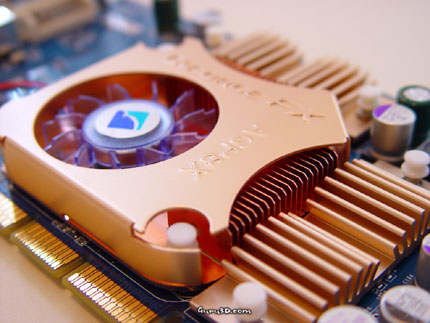Page 8 - Overclocking
Performance - Overclocking
Of course with most videocards we can do some easy tricks to boost the overall performance a little. It's called overclocking the videocard and by increasing the frequency of the videocards memory and gpu we can make the videocard increase it's calculation clock cycles per second. It sounds hard but it really can be done in less then a few minutes. I always tend to recommend to novice users and beginners not to increase that frequency any higher then 5-10% of the core and memory clock. Example: if your card would run at 300 MHz then I suggest you don't increase that frequency any higher than 330 MHz.
More advanced users push that frequency often way higher. Usually when memory starts to show white dots 'snow' you should go down 10 MHz and leave it at that. The core can be somewhat different. Usually when you are clocking to hard it'll start to show artifacts, empty polygons or it will even freeze. I recommend that you back down at least 10-15 MHz from the moment you notice an artifact. Look carefully and observe well.
All in all .. do it at your own risk. Overclocking your card too fast or constantly to it's limit might damage your card and it's not covered by your warranty.
You will benefit from overclocking the most with product that is limited or you may called it 'tuned down'. Now then, we know that this graphics core is likely more powerful then what we have seen in the previous benchmarks. Therefore by increasing the memory and core frequency we should be able to witness some higher performance results.
Will the cooling solution help cooling down the graphics card enough for a nice overclock ?Overclocking wise the videocards did reasonably well. The 5200 could be clocked higher nominal however we halted testing this card overclocked as it just ran too hot, even at default settings. Therefore in this review we will not include overclocking result on the non-active cooled 5200.
The 5600 was another story though. Remember, we don't do just one quick test-run to see how far it clocks. No, the overclock is enabled all the way and must return it's results without crashing or graphics anomalies in _all_ benchmarks properly to be called stable. We where able to boost it up towards 375-380 MHz for the core.
At that frequency the card remained completely stable. Memory results maxed out at around 730 (2x 365) MHz. In our reviews is we'll include the overclocking result for all benchmarks. So on the next pages you'll see them.
| Test system |
|
Test system setup:
Benchmark Software Suite:
* disabled while benchmarking |
All tests where made in 32 bit colors in resolutions ranging from 800x600 pixels up-to the Godfather of all gaming resolutions, the 1600x1200 several performance/quality settings.

